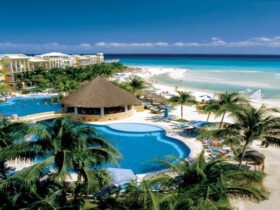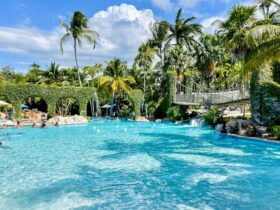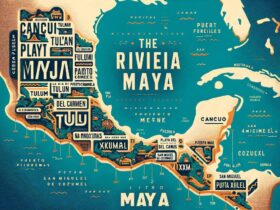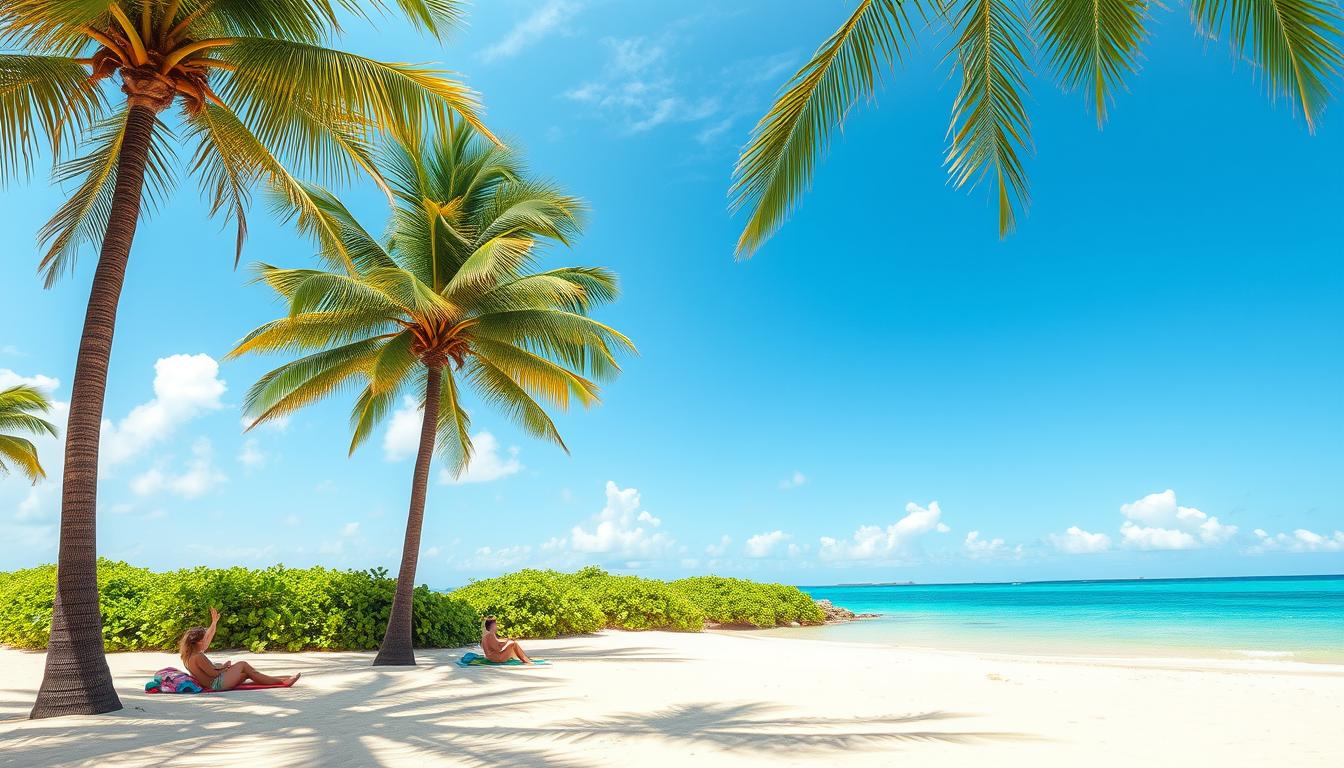Planning a trip to Playa del Carmen and looking for pristine beaches without seaweed? You’re in the right place! We’ve crafted this guide to help you discover the best spots to enjoy the sun, sand, and crystal-clear waters of the Riviera Maya.
Seaweed levels can change daily and seasonally, so staying informed is key. Live updates from sources like the Secretaría de Medio Ambiente and the latest color-coded maps (updated as recently as January 25, 2025) are invaluable tools for planning your visit. Whether you’re seeking a relaxing day by the ocean or an adventurous snorkeling adventure, we’ve got you covered.
Our guide is designed with professional local insights to ensure you make the most of your time in Mexico. From hidden gems to well-known spots, we’ll show you how to navigate the dynamic seaweed conditions and find your perfect beach.
Key Takeaways
- Seaweed levels in Playa del Carmen vary by day and season.
- Use live updates and color-coded maps for planning.
- Some beaches, like those near reefs, are less affected by seaweed.
- Riviera Maya resorts often maintain cleaner beaches.
- Consider visiting during the dry season for clearer waters.
Ready to explore? Dive into our guide and discover the best seaweed-free beaches in Playa del Carmen. For more on top Riviera Maya resorts, visit Riviera Maya Resorts.
Understanding the Seaweed Situation in Playa del Carmen
Curious about why seaweed has become a common sight in this tropical paradise? Let’s dive into the science behind it.
What Causes Sargassum and Brown Algae?
The influx of sargassum and brown algae along the coast is primarily driven by ocean currents. These currents carry the seaweed from the Sargasso Sea, a vast body of water in the North Atlantic. Climate change and pollution have accelerated the growth of these algae, making the problem more pronounced in recent years. As the seaweed washes ashore, it brings challenges for both the environment and tourism.
Seasonal Patterns and Ocean Currents
Understanding the seasonal patterns is crucial. The sargassum season typically runs from April to October, with warm ocean temperatures fueling its growth. Hotels and resorts in the Maya region have implemented various management strategies to maintain clean shores. By staying informed about these patterns, visitors can better plan their trips to Mexico and enjoy the beautiful coastline.
As you plan your visit, remember that knowledge is power. Stay updated with the latest reports and choose accommodations that prioritize beach maintenance. With a little insight, you can still experience the pristine beauty of this Mexican gem.
Using Live Webcams and Maps to Check Beach Conditions
Staying ahead of seaweed levels is easier than ever with modern tools. Real-time webcams and detailed maps offer a clear view of what to expect before you arrive. These resources empower you to make informed decisions and enjoy your time in paradise.
Accessing Playa del Carmen Beachfront Live Cameras
Several beachfront hotels provide live webcam feeds. For instance, the Playa Palms Beach Hotel and Casa Tucan offer real-time views. These cameras let you see the current conditions, helping you plan your day effectively.
Imagine checking the webcam in the morning and seeing crystal-clear water. This feature is invaluable for planning your activities, whether it’s swimming or simply relaxing on the shore.
Interpreting the Color-Coded Seaweed Map
The color-coded map is another essential tool. Green indicates minimal seaweed, yellow suggests moderate amounts, orange means significant presence, and red signals heavy seaweed. Understanding these colors helps you choose the best spots quickly.
By checking these tools, you can save your day and enjoy optimal conditions.Stay informed and make the most of your visit.
These resources are updated throughout the year, ensuring you always have the latest information. Whether you’re planning a day trip or a longer stay, these tools are your key to a seamless experience.
Guide to Playa del Carmen Beaches without Seaweed
Exploring the Caribbean coastline? Discover our expert guide to finding serene spots along the Riviera Maya where you can unwind on stunning shores.
Natural coastal formations play a significant role in reducing seaweed accumulation. For instance, beaches near coral reefs often experience fewer seaweed deposits due to the ocean currents. Additionally, local management practices, such as installing algae barriers, have been effective in maintaining clean shores.
| Beach Location | Why It’s Ideal |
|---|---|
| Cenote-filled lagoons | Protected from strong currents, these spots naturally trap less seaweed. |
| West-facing shores | These areas are less exposed to seaweed brought by Caribbean currents. |
| Reef-protected bays | Natural barriers reduce the amount of seaweed that reaches the shore. |
Using regional maps and real-time updates, you can pinpoint low seaweed areas easily. For example, the Hard Rock Hotel Riviera Maya features an inland beach protected by a rocky breakwater, ensuring a seaweed-free experience.
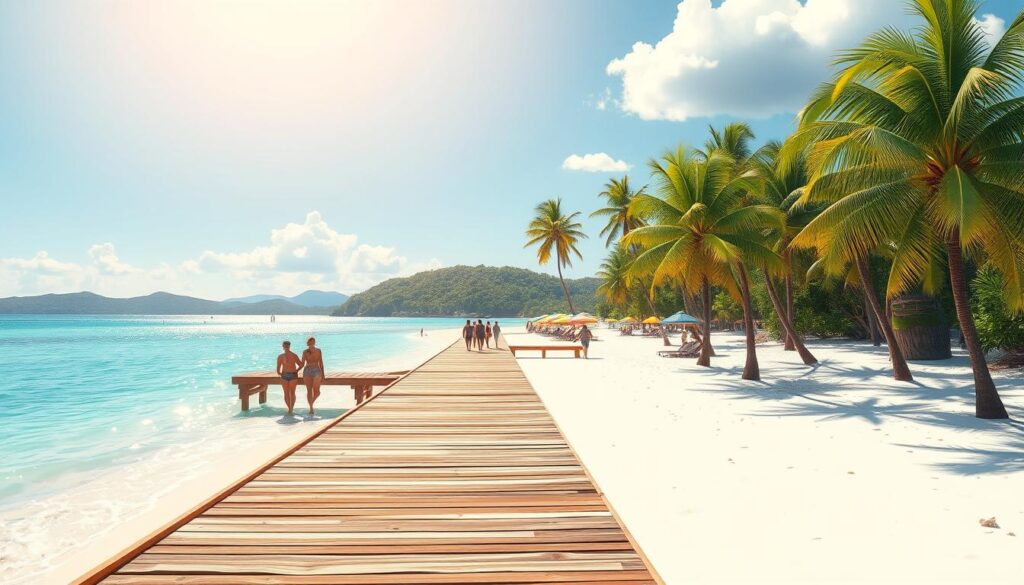
Plan your visit during the winter months for clearer waters, as this is when seaweed levels are typically lower. For more on top Riviera Maya resorts with excellent beach maintenance, visit Riviera Maya Resorts.
Tips for Choosing Seaweed-Free Accommodations
When planning your Caribbean getaway, selecting the right accommodations can make all the difference. We’re here to guide you in picking the perfect spot where you can enjoy the ocean without unwanted seaweed.
Resorts with Onsite Seaweed Management Methods
Many top-tier resorts in the Riviera Maya have implemented innovative solutions to keep their shores clean. Some use barrier nets to prevent seaweed from reaching the shore, while others employ regular cleaning routines. These proactive measures ensure that guests can fully enjoy the crystal-clear waters and pristine sands.
For instance, resorts in Isla Mujeres and nearby areas are known for their rigorous beach maintenance programs. These efforts not only enhance the guest experience but also protect the delicate marine ecosystem.
How to Select a Hotel Based on Beach Conditions
Monitoring month-to-month changes in seaweed levels can significantly influence your choice of hotel. Consider staying at Mayan resorts, which are often located in areas with natural barriers like coral reefs. These locations tend to have fewer seaweed deposits due to their unique geography.
- Research the hotel’s beach maintenance practices.
- Check live webcams for real-time beach conditions.
- Ask about their seaweed management procedures directly.
By taking these steps, you can ensure a worry-free vacation where you can fully enjoy the beauty of the ocean.
Alternative Activities When Beaches are Affected by Seaweed
Even when seaweed affects the shoreline, your vacation can still be memorable. The area offers a variety of exciting activities that let you explore beyond the beach.
Exploring Cenotes and Underwater Adventures
Cenotes are natural swimming holes connected to underground rivers, offering a unique experience. These crystal-clear waters provide a refreshing escape from the sea. Many cenotes are located near ancient Mayan ruins, adding a historical touch to your adventure.
| Cenote | Activities |
|---|---|
| Cenote Calavera | Snorkeling, swimming, and rappelling |
| Cenote Azul | Swimming, jumping from cliffs, and zip-lining |
| Cenote Cristalino | Snorkeling, diving, and relaxing in clear waters |
These destinations are perfect for adventure seekers looking to explore the area’s natural beauty.
Discovering Mayan Ruins and Local Tours
Immerse yourself in history by visiting ancient Mayan sites like Tulum National Park and Chichen Itza. Guided tours provide insights into the region’s rich cultural heritage. For a deeper connection with the area, consider:
- Exploring eco-parks like Xcaret or Xel-Ha for a mix of culture and nature
- Participating in local workshops to learn traditional crafts
- Joining gastronomic tours to experience regional cuisine
Staying informed about local conditions through updates and guides helps you make the most of your trip. Whether you’re interested in history, nature, or culture, the area offers endless opportunities for unforgettable experiences.
Effective Methods and Solutions for Sargassum Management
Managing sargassum along the coast requires a combination of traditional methods and innovative solutions. From mechanical removal to biological approaches, these techniques help maintain pristine shores for every person enjoying their vacation.
Mechanical, Biological, and Innovative Techniques
Resorts and local authorities in areas like Tulum have implemented various strategies to combat sargassum. These methods ensure a clean coastal environment and an enjoyable experience for all visitors.
- Mechanical Removal: Specialized equipment like SurfRakes efficiently collects sargassum, leaving wet sand intact. This method is widely used by resorts such as Banyan Tree Mayakoba and Fairmont Mayakoba.
- Biological Controls: Introducing natural predators helps control seaweed growth without harming the environment. This eco-friendly approach is gaining traction along the coast.
- Innovative Solutions: Barrier nets and underwater containment systems prevent sargassum from reaching the shore. These methods are particularly effective in Tulum, where the coast is protected by over 2,300 meters of barriers.
| Method | How It Works | Benefits |
|---|---|---|
| Mechanical Removal | Uses machinery to collect seaweed | Efficient and quick cleanup |
| Biological Controls | Introduces natural predators | Eco-friendly and sustainable |
| Innovative Barriers | Prevents seaweed from reaching shore | Long-term solution with high effectiveness |
These methods not only protect the coast but also enhance the overall appeal of your stay. For more on top Tulum resorts with excellent beach maintenance, visit Tulum Resorts.

Seasonal Trends and Weather Impact on Seaweed Levels
Seasonal weather patterns play a significant role in shaping the sargasso situation in the Riviera Maya and Yucatan. Understanding these trends can help you better plan your visit and avoid unexpected beach conditions.
High Seaweed Seasons and Predictive Factors
The presence of sargasso peaks during warmer months, typically between April and October. This period sees higher water temperatures, which accelerate algae growth. Weather changes and tropical disturbances can also significantly impact seaweed levels.
- High seaweed levels are common in summer due to warm ocean temperatures.
- Water temperature and weather changes are key predictive factors.
- Regional maps track seasonal trends across the Yucatan.
- Understanding these patterns helps plan your trip effectively.
- Weather events can lead to temporary beach “ruin” or recovery.
| Season | Sargasso Levels | Impact |
|---|---|---|
| Spring/Summer | High | Warm waters fuel growth, increasing sargasso. |
| Fall/Winter | Low | Cooler temperatures reduce sargasso presence. |
| Tropical Storms | Variable | Can temporarily reduce sargasso levels. |
By monitoring these seasonal trends and using predictive tools, you can better navigate the sargasso situation and enjoy your time in the Yucatan. Stay informed and plan wisely to make the most of your visit.
Planning Your Itinerary: When and Where to Visit
Creating a well-structured itinerary is key to enjoying your time on the Yucatan Peninsula. Whether you’re interested in exploring ancient ruins, relaxing in crystal-clear waters, or experiencing the vibrant culture, planning ahead ensures a seamless experience.
Finding the Perfect Time to Explore
Summer months offer a unique charm, with warm weather ideal for outdoor activities. However, it’s important to balance your plans with the seasonal trends. The peninsula offers a variety of attractions, from historical sites to natural parks, making it easy to find activities that suit your interests.
- Summer tours often include visits to cenotes and Mayan ruins.
- Guided tours provide insights into the region’s rich history and hidden gems.
- Parks like Xcaret and Xel-Ha offer a mix of culture and nature.
For a comprehensive experience, consider visiting during the dry season when the weather is pleasant, and the waters are clearer. This period is ideal for both beach activities and inland excursions.
By balancing your itinerary with both beach and inland activities, you can fully experience the beauty of the Yucatan Peninsula. Whether you’re interested in history, nature, or adventure, there’s something for everyone to enjoy.
Conclusion
As we conclude our journey through the best seaweed-free spots and expert tips for navigating this tropical paradise, we want to leave you with a sense of confidence and excitement for your next adventure. While seaweed can present challenges, there’s a lot being done to minimize its impact and ensure your vacation is nothing short of unforgettable.
Our guide has provided you with a wealth of insights, from real-time monitoring tools to innovative management methods. We’ve highlighted how reefs and natural barriers play a significant role in reducing the amount of seaweed that reaches the shore. By staying informed and choosing the right accommodations, you can enjoy crystal-clear waters and pristine sands.
Remember, a little extra planning goes a long way. Consider the seasonal trends, check live updates, and explore the hidden gems this region has to offer. Whether you’re seeking relaxation or adventure, the solutions are here to help you make the most of your time.
Stay informed, plan wisely, and let this guide be your trusted companion as you embark on your journey. For more on top resorts that prioritize beach maintenance, visit Riviera Maya Resorts. With the right knowledge, you’ll find that this destination still shines brightly as a tropical gem.



